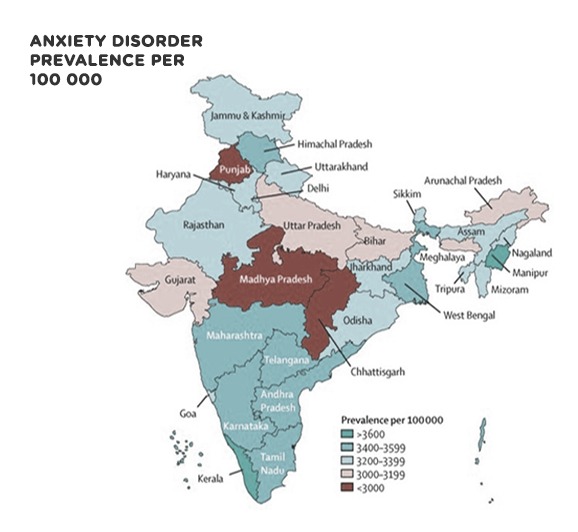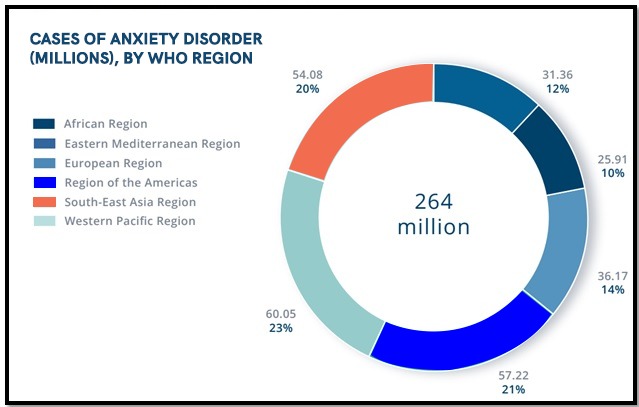Anxiety is the feeling which is characterized by physical alterations, tension, and worried thoughts. People suffering from anxiety disorder generally have periodical intrusive concerns which may cause them to keep away from situations out of tension.
Some of them also possess symptoms like dizziness, trembling, sweating (Anxiety, 2020). This is the most relevant emotional disorder which may affect people of any age group. This disorder often causes a frightening feeling and makes one feeble and weak (Healthline, 2020).
Some agonize from intense attacks of anxiety and some bear with panic from the thought of being socialized during celebrations or functions. Anxiety disorder is a mental health problem and is highly responsive to treatment. However, this curable disease is taking slowly taking the shape of a pandemic in Asian countries and people belonging to Asian origin.
Khambaty and Parik (2017) identified that cultural factors have a significant impact on the presentation, diagnosis, and treatment of anxiety disorders. In Indian context mental disorders have been represented in several ancient Indian texts. Like in Ramayana which was composed almost 5000 BCE, Marrich was depicted as some “hyperarousal, re-experiencing of events, and avoidance” (Sheth, Gandhi and Vankar, 2010). In Shrimad Bhagavatam, an epic that was written in 400 BCE by Maharshi Ved Vyasa, describes King Kansha as someone who suffered from generalized anxiety disorder (GAD).
Recently, the Times of India in one of their report noted that 1 among 7 persons in India is suffering from mental health issues; anxiety and depression are the most prevalent mental issues in India. Sagar et el. (2020), in their research, found that a mental disorder is “among the leading causes behind the non-fatal disease burden on India”.The authors further reported that 197.3 million people in India are suffering from some kind of mental disorder among which 44.9 million suffered from anxiety disorders.
States like Manipur and Kerala has the highest rates of Anxiety disorder.

In Asian countries like Korea, Japan, and China, the National Comorbidity Replication and National Comorbidity Survey results showed the prevalence rates of 0.6 %, 0.8%, and 0.2% respectively (Verywell Mind, 2020).
In Singapore around 10% of the population suffers from depressive and anxiety disorder, out of which 6% suffer from depression, 0.9% suffer from GAD and about 3% suffer from OCD.
Generally women, middle-aged people with anxious nature, and one with negative events of life like job loss, relationship failures, etc (Healthxchange.sg, 2020)
According to the World Health Organization, the South East Asian region tops the world in the number of people suffering from Anxiety disorders. Nearly 23% of the total population was found to be suffering from some kind of Anxiety disorders.

According to the study conducted by Hofmann and Hinton (2014), the Asian population in America is more likely to be diagnosed with a generalized anxiety disorder and PTSD as compared to other ethnic groups. Since most Asian countries are collectivist hence the individuals in Asian cultures are more likely to feel embarrassed as compared to their western counterparts.
Issues in Asian Countries regarding mental health:
The high prevalence of mental health issues is due to two factors; socio-cultural factors and infrastructural factors.
When analyzing the Anxiety disorders, it can be seen that the cultural variations exist and make sense when cultural differences have social expectations and rules. The cultural background of a person often affects the emotional expression as well as the experience. It has been recognized that the contextual (linked with social rule and norms which led to collectivism, self-construals, and individualism) and ethnophysiology/ethnopsychology (includes concepts about bodily and mental processes) factors impact anxiety disorder and are considered while evaluating the reaction among anxiety disorder and culture (Hofmann and Hinton, 2014).
Apart from the cultural factors, several infrastructural issues have been acting as a barrier for people suffering from mental health issues to get proper treatment. In developing Asian countries like India, Pakistan, Bangladesh, Srilanka, Afghanistan among others there is a lack of sufficient information on the prevalence, disease burden, and risk factors. This information is very crucial for developing appropriate policies and health system responses that could address the mental health burden more effectively.
In the majority of the Asian countries despite the various efforts by Government and non-government organizations, there is a very poor implementation of mental health services. There exists a high treatment gap in the case of mental disorders, lack of evidence-based treatment, and non-existent gender differentials during treatment. There is a severe shortage of mental health professionals. For example in India for every 10,000 people, there are only 2 mental health workers and 0.3 psychiatrists which are way below the global average. There is also a discriminatory attitude faced by people with mental health issues by mental health workers. There are other barriers in the Asian countries like “low perceived need for care, paucity of knowledge of mental disorders, and stigma attached to mental disorders” (Sagar et al., 2020). There is an immediate need in developing Asian countries to put in place an integrative approach for detection, treatment, and managing the patient needs that are associated with mental health issues as people suffering from mental disorders have a higher rate of premature deaths.
Treatment:
One should remember that no such way has been found to foresee the causes which develop these types of disorders but steps can be taken for reducing the impact by getting help earlier, staying active and avoiding the consumption of drugs or alcohol, etc. Sometimes if someone does not seek help then the condition may get worse and one should visit a mental health provider, as early help makes the treatment easier.
There is an important role that is played by the community and families in addressing the mental health issues by eliminating stigma, discrimination, increasing awareness, and promoting inclusion. There is significant potential in the community-based programs to decrease the treatment gap of mental health issues.
There is also a need to put in place school-based mental health programs and adopting traditional practices like Yoga which has been proven to beneficial for several mental health issues. The government can also focus on the task-sharing of mental health workers with non-specialists that can allow training the community health workers to improve the provision of mental health services. Finally through tele-medicines can provide mental health services even in remote areas which are inaccessible, increasing the number of internet-based and telephone-based help-lines and launching mental health mobile applications that can bring down the burden on the existing mental health services. Hence there is now a need for Asian countries like India to make significant investments in mental health service facilities for facilitating prevention wherever possible and offering affordable treatment, care, and rehabilitation along with programs to integrate mental and physical health services.





